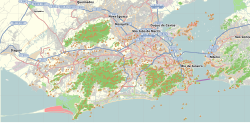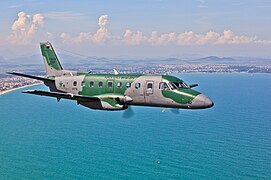| Santa Cruz Air Force Base | |||||||
|---|---|---|---|---|---|---|---|
Base Aérea de Santa Cruz | |||||||
| Rio de Janeiro, Rio de Janeiro in Brazil | |||||||
 Santa Cruz Air Force Base (2022) | |||||||
| Coordinates | 22°55′58″S 043°43′10″W / 22.93278°S 43.71944°W | ||||||
| Type | Air Force Base | ||||||
| Code | ALA12 | ||||||
| Site information | |||||||
| Owner | Brazilian Air Force | ||||||
| Controlled by | |||||||
| Open to the public | No | ||||||
| Website |
www | ||||||
| Site history | |||||||
| Built | 1936 | ||||||
| In use | 1942-present | ||||||
| Garrison information | |||||||
| Current commander | Cel. Av. Alessandro Barbosa Arrais de Oliveira | ||||||
| Occupants |
| ||||||
| Airfield information | |||||||
| Identifiers | IATA: SNZ, ICAO: SBSC, LID: RJ9003 | ||||||
| Elevation | 3 metres (10 ft) AMSL | ||||||
| |||||||
| Source: DECEA [1] | |||||||
Santa Cruz Air Force Base – ALA12 ( IATA: SNZ, ICAO: SBSC) is a base of the Brazilian Air Force, located in the district of Santa Cruz in Rio de Janeiro, Brazil.
History
The base was originally called Bartolomeu de Gusmão Airport and it was constructed to handle the operations with the rigid airships Graf Zeppelin and Hindenburg. Between 1931 and 1937, Deutsche Luft Hansa had regular flights between Germany and Brazil, with Rio de Janeiro as final stop. For this reason Luftschiffbau Zeppelin decided to construct a dedicated facility and move its operations from Campo dos Afonsos Airport. [2] The airport was inaugurated on 26 December 1936. The whole complex consisted of an airfield, the hangar, a hydrogen factory and a branch-line connecting the complex to the main railway line to downtown Rio de Janeiro 54 km away among other structures. [3] Some of the buildings are still in use, particularly the hangar which was built to accommodate the rigid airships. Because it is the only original surviving hangar built for rigid airships in the world, on 14 March 1999, it was listed as a National Heritage Site.
As a consequence to the Hindenburg disaster on 6 May 1937 at Lakehurst Air Naval Station in New Jersey, US, the Luftschiffbau Zeppelin requested to the Brazilian Government on 17 June 1937 the suspension of services. Since then no more civil operations were handled at this facility.
On 12 February 1942, six months before Brazil declaring war against the Axis, the airport was commissioned as a base of the Brazilian Air Force. The name of the facility was changed to Santa Cruz Air Force Base on 16 January 1943, [4] even tough, according to a law prescribing rules for the naming of airports of July 21, 1953, the name of the facility could officially and exceptionally be maintained as Bartolomeu de Gusmão Airport. [5]
Units
The following units are based at Santa Cruz Air Force Base:
- 1st Squadron of the 7th Aviation Group (1°/7°GAv) Orungan, using the P-3AM Orion, and the Elbit RQ-1150 Heron. [6]
- 3rd Squadron of the 8th Aviation Group (3°/8°GAv) Puma, using the H-36 Caracal. [7]
- 1st Fighter Aviation Group (1ºGAvC), comprising the (1°/1°GAvC) Jambock Squadron, and the (2°/1°GAvC) Pif-paf Squadron, using the F-5EM & FM. [8]
- 1st Squadron of the 1st Communications and Control Group (1º/1ºGCC) Profeta, using radars and equipment for air defense. [9]
Accidents and incidents
- 7 August 1951: Brazilian Air Force, a Douglas C-47 Skytrain registration FAB-2028 struck a hillside reportedly following an engine failure and crashed upon approach to Santa Cruz. The crew of 4 died. [10]
- 3 May 1982: a Royal Air Force Avro Vulcan was intercepted by two F-5E aircraft of the 2nd Squadron of the 1st Group of Combat Aviation (2°/1°GAvC) Pif-paf based at Santa Cruz. The Vulcan had finished the Operation Black Buck 6 during the Falklands War and was returning to Ascension Island when it suffered technical problems. It was intercepted upon entering Brazilian airspace and made to land at the Galeão Air Force Base. The Brazilian aircraft flew back to Santa Cruz having successfully accomplished the first real interception mission in their history. [11] [12] [13]
Access
The base is located 54 km from Rio de Janeiro downtown in the district of Santa Cruz.
Gallery
This gallery displays aircraft that are or have been based at Santa Cruz. The gallery is not comprehensive.
Present aircraft
-
Lockheed P-3AM Orion (FAB)
-
Eurocopter H-36 Caracal (FAB)
-
Northrop F-5EM (FAB)
Retired aircraft
-
Gloster F-8 Meteor
-
Lockheed TF-33A T-Bird
-
A-1 AMX
-
Embraer C-95B Bandeirante (FAB)
See also
References
- ^ "CAMPO NERO MOURA (SBSC)". DECEA (in Portuguese). Retrieved 19 August 2023.
- ^ Instituto Histórico-Cultural da Aeronáutica (1990). História Geral da Aeronáutica Brasileira: de 1921 às vésperas da criação do Ministério da Aeronáutica (in Portuguese). Vol. 2. Belo Horizonte and Rio de Janeiro: Itatiaia and Instituto Histórico-Cultural da Aeronáutica. pp. 164–166.
- ^ Instituto Histórico-Cultural da Aeronáutica (1990). História Geral da Aeronáutica Brasileira: de 1921 às vésperas da criação do Ministério da Aeronáutica (in Portuguese). Vol. 2. Belo Horizonte and Rio de Janeiro: Itatiaia and Instituto Histórico-Cultural da Aeronáutica. pp. 384–392.
- ^ Instituto Histórico-Cultural da Aeronáutica (1991). História Geral da Aeronáutica Brasileira: da criação do Ministério da Aeronáutica ao final da Segunda Guerra Mundial (in Portuguese). Vol. 3. Belo Horizonte and Rio de Janeiro: Villa Rica Editoras Reunidas. p. 272.
- ^ "Lei no 1.909, de 21 de julho de 1953". Presidência da República (in Portuguese). 21 July 1953. Retrieved 15 October 2023.
- ^ "1º/7º GAv – Esquadrão Orungan". Spotter (in Portuguese). Retrieved 1 May 2021.
- ^ "3º/8ºGAv – Esquadrão Puma". Spotter (in Portuguese). Retrieved 1 May 2021.
- ^ "1º/1º GAvC – Esquadrão Jambock and 2º/1º GAvC – Esquadrão Pif-paf". Spotter (in Portuguese). Retrieved 1 May 2021.
- ^ "Esquadrões de comunicações e controle de todo o país mobilizam pessoal e equipamentos". Força Aérea Brasileira (in Portuguese). 9 November 2018. Retrieved 5 May 2021.
- ^ "Accident description FAB-2028". Aviation Safety Network. Retrieved 1 May 2021.
- ^ "Operation Black Buck". Mongsoft. Retrieved 12 May 2011.
- ^ "Operação Black Buck: A invasão dos Avro Vulcan nas Ilhas Malvinas". Aeroflap (in Portuguese). Retrieved 1 May 2021.
- ^ Gonçalves da Costa Pereira, Elaine (2018). O céu é nosso!: A defesa aérea brasileira (PDF). Opúsculos (in Portuguese). Vol. 47. Rio de Janeiro: Instituto Histórico-Cultural da Aeronáutica. pp. 35–38.
External links
- Airport information for SBSC at Great Circle Mapper. Source: DAFIF (effective October 2006).
- Current weather for SBSC at NOAA/ NWS
- Accident history for SBSC at Aviation Safety Network









